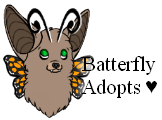
Pygmy Fae are small, lizard-like creatures with a soft mane. This mane keeps them warmer during the wintertime, and depending on the length of the fur, it can also be used to store certain small items. They have crests, with a large variety of colors, shapes, and sizes, along with large antennae with glowing bulbs. These antennae not only help them find each other, but can be used to communicate, as the fae can control the brightness of them. The bulbs are usually dim or not glowing at all when the fae is upset or angry, and can glow very brightly when the fae is happy or excited.
Fae generally prefer forests or meadows, typically any place with lots of greenery. They sleep in places they can find, or may sometimes burrow a hole and, due to their intelligence, could even "construct" a home out of various objects. Though they prefer greenery, they can be found in a variety of climates and make the most of their surroundings.
Their diet typically consists of nuts, berries, and other various fruit. They are omnivores, but most prefer to eat non-meats. If they eat meats, they will usually scavenge for it instead of hunt, as they aren't very powerful predators. They also sometimes like to drink flower nectar as a tasty treat every once in a while. Fae are usually about the size of a young kitten, weighing roughly up to 1.5 pounds and no less than 12 ounces.
Breeding between fae is inetersexual. Typically before mating, one fae will "court" the other with a small dance. One fae will lay up to 2 eggs and both fae will take turns incubating the eggs. After a 2 week period, the eggs will hatch and the young fae (called faelings) will be taken care of by their parents. During their young period, up until about 5 weeks old, they eat small, soft berries and insects. Upon reaching 5 weeks is when they're typically ready to explore on their own. Fae are a family- and pack-oriented species, and often still stay together even after reaching the age where they can survive on their own as it increases their survivability, and they love the company.
The fae's bright antennae are typically used to guide lost pets, kids, and other animals back to safety. A lot of rescue teams like to use them, since they have good tracking abilities and the bright glow is known to be very appealing to young kids. Fae communicate through various hums, trills, and clicks. With the noises they can make, they often like to make "music" - and when another fae hears the song, they will more than likely join in, resulting in a large "choir" of fae.


It's currently unknown where fae originated from. They first appeared when a couple of miners broke into a cave. It was dark at first, and then all the sudden, hundreds and thousands of lights gradually brightened on the walls and floors and even the ceiling of the cave. "It was like magic," They told reporters. "Suddenly the lights moved, and that's when we realized they were creatures and not some strange objects." It is presumed these creatures went into a form of hibernation many years ago, and the cave became blocked up during that period. Researchers aren't sure why they haven't passed, with how long it must have been with them in there. Fae are being closely studied, and people have found potential in the use of them for rescue teams and for finding objects or people. They have been deemed safe for interaction and have been shown to be very loving and and adore attention.

 Normal:
Normal: antennae variations, crest variations, body weight variations
Frequent: fur length variations, tail variations, whiskers
Uncommon: animal ears, fur in other locations, larger or different claws, faux-wings,
Mutations: Multiple eyes, eyes on the body, multiple legs, multiple tails, horns, horns on the body, multiple crests, large fangs or tusks,
Abnormal: Feathered or bat-like wings, fullbody glow, holes in the body
(Abnormal traits are VERY RARELY found in fae and are still under investigation.)
Faux-wings are flaps of skin connected at the elbow point from the front ankles or so, up to the thighs or knees of the hind legs, similar to a
gliding lizard. These can ONLY be used for gliding.
Mutations have a chance of occurring in breeding and an even rarer chance of occurring out in the wild. Fae may be given medicine to force mutation in offspring.
























































